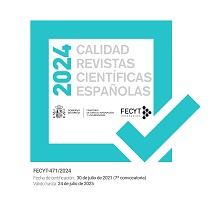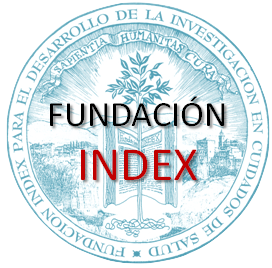Engagement o compromiso en profesionales de enfermería: variables socio-demográficas y laborales asociadas
Agencias de apoyo
- Universidad de Zaragoza. Departamento de Psicología y Sociología
Resumen
Objetivos: Determinar el nivel de engagement y la relación con las seis áreas de la vida laboral en los profesionales de enfermería en la ciudad de Huesca (España) y su asociación con las variables socio-demográficas y laborales.Materiales y Método: Estudio descriptivo, transversal, con abordaje cuantitativo, en el que participaron 305 profesionales de enfermería. Se realizó un análisis descriptivo, correlaciones y pruebas paramétricas bivariadas, ANOVA y T-Student.
Resultados: La mayoría de los participantes eran mujeres, con pareja estable e hijos, con edad media de 44,98 años (DT 10,86). El 35,4% de la muestra presenta altos niveles de engagement (altos niveles de energía, implicación y eficacia). El estado civil, la situación laboral del cónyuge y padecer enfermedades crónicas se relaciona con los niveles de eficacia; las actividades de ocio se relacionan con los niveles de energía e implicación. La valoración del clima laboral se relaciona con las tres áreas del engagement; la edad, el tiempo en la unidad de trabajo, los años como enfermera y el tiempo en un puesto de dirección se relacionan con la implicación.
Conclusiones: La población estudiada presenta altos niveles de engagement laboral y congruencia entre las sub-escalas de la vida laboral y la organización, con la excepción de la sub-escala de justicia, puesto que los individuos encuestados creen que la organización los trata de forma injusta.
Descargas
Citas
Alligood MR, Merriner Tomey A. Modelos y teorías en enfermería. 7ª ed. Barcelona: Elsevier; 2011.
Waldow VR, Borges RF. El proceso de cuidar según la perspectiva de la vulnerabilidad. Rev Latino-am Enfermagem. 2008 julho-agosto; 16(4).
Burgos Moreno M, Paravic Klijn T. Enfermería como profesión. Rev Cubana Enfermería [internet]. 2009; 25(1-2)[consultado 23 Mar 2016]. Disponible. en:http://bit.ly/11LW4sh
Mingote Adán JC. Síndrome de burnout o síndrome de desgaste profesional. Formación Médica Continuada. 1998; 5(8): 493-508.
Moreno B, González JL, Garrosa E. Desgaste profesional
(burnout), personalidad y salud percibida. En J. Buendía y F. Ramos (Eds.). Empleo, Estrés y Salud. Madrid: Pirámide; 2001. p. 59-83.
Maslach C, Jackson SE. Burned-out cops and their families.
Psychology Today. 1979; 12 (12): 59-62.
Leiter MP, Maslach C. Burnout. En H. Friedman (Ed.). Encyclopedia of Mental Health. San Diego, CA: Academic Press; 1998. P. 347-357.
Rodriguez-Muñoz A, Bakker AB. El engagement en el trabajo. En B. Moreno-Jimenez E. Garrosa Hernandez (Eds.). Salud laboral: Riesgos laborales psicosociales y bienestar laboral. Madrid: Pirámide; 2013. p. 437-452.
Schaufeli WB, Salanova M, Gonzalez-Roma V, Bakker AB. The measurement of burnout and engagement: A confirmatory factor analytic approach. Journal of Happiness Studies. 2002; 3:71-92.
Schaufeli WB, Taris T, Le Blanc P, Peeters M, Bakker AB, De Jonge J. Maakt arbeid gezond? Op weg naar een positieve Arbeids- en Gezondheidspsychologie. De Psycholoog. 2001; 36:422-428.
Schaufeli WB, Salanova M. Work engagement. Managing social and ethical issues in organizations. 2007: 135-177.
Harter JK, Agrawal S. Cross-cultural analysis of Gallup’s Q12 employee engagement instrument. Omaha, NE: Gallup. 2011.
May DR, Gilson RL, Harter LM. The psychological conditions of meaningfulness, safety and availability and the engagement of the human spirit at work. Journal of Occupational and Organizational Psychology. 2004; 77: 11-37.
Schaufeli WB, Salanova M, González-Romá V, Bakker AB. The measurement of Engagement and burnout: A confirmative analytic approach. Journal of Happiness Studies. 2002; 3: 71-92.
Leiter MP, Maslach C. Areas of worklife: A structured approach to organizational predictors of job burnout. En P. L. Perrewe & D. C. Ganster (Eds.). Research in Occupational Stress and Well-Being. Oxford: Elsevier; 2004). P. 91-134.
Gascón S, Leiter MP, Srtight N, Santed MA, Montero-Marín J, Andrés E, et al. A factor confirmation and convergent validity of the “areas of worklife scale” (AWS) to Spanish translation. Health and Quality of Life Outcomes. 2013; 11:63.
Van Bogaert P, van Heusden D, Timmermans O, Franck E. Nurse work engagement impacts job outcome and nurse-assessed quality of care: model testing with nurse practice environment and nurse work characteristics as predictors. Frontiers in Psychology. 2014 Nov; 5.
Lee HF, Yen M, Fetzer S, Chien TW. Predictors of Burnout Among Nurses in Taiwan. Community Ment Health J. 2015 Aug;51(6):733-7.
Instituto Nacional de Estadística [sitio web]. Madrid: INE
[actualizada 1 de enero 2013; consultado 29 de diciembre de 2015]. Disponible en: http://www.ine.es/inebmenu/indice.htm
- García Encabo M, De la Bárcena Guallar J. Mapa sanitario de la comunidad autónoma de Aragón. Sector Huesca [monografía en internet]*. Zaragoza: Gobierno de Aragón. Departamento de Salud y Consumo; 2008 [acceso 29 de diciembre de 2015]. Disponible en: http://www.aragon.es/estaticos/ImportFiles/09/docs/Ciudadano/GuiaCentrosServiciosSanitarios/OrdenacionSanitaria/MapaSanitario/MS_HUESCA.PDF
Castrodeza Sanz JJ, Alfaro Latorre M, Gogorcena Aoiz MA, Alonso Villar C, de Bustos Guadaño M, Jimenez Rosado P, et al. Catálogo Nacional de Hospitales 2015 [monografía en internet]*. Madrid: Ministerio de Sanidad, Servicio Sociales e Igualdad; 2014 [acceso 4 de enero de 2016]. Disponible en: http://www.msssi.gob.es/ciudadanos/prestaciones/centrosServiciosSNS/hospitales/docs/CNH2015.pdf
Fiabane E, Giorgi I, Sguazzin C, Argentero P. Work engagement and occupational stress in nurses and other healthcare workers: the role of organisational and personal factors. J Clin Nurs. 2013 Sep; 22(17-18):2614-24.
Setti I, Argentero P. Organizational features of workplace and job engagement among Swiss healthcare workers. Nurs Health Sci. 2011 Dec;13(4):425-32.
Mahboubi M, Ghahramani F , Mohammadi M, Amani N, Mousavi SH, Moradi F. Evaluation of Work Engagement and Its Determinants in Kermanshah Hospitals Staff in 2013. Global Journal of Health Science. 2015; 7(2):170-176.
Fuentelsaz Gallego C, Moreno Casbas T, López Zorraquino D, Gómez García T, González María E, Consorcio RN4CAST-España. Perception of work environment of nurses in hospitals of the Spanish national health system. RN4CAST-Spain Project. Enferm Clin. 2012; 22(5):261-268.
Cho J, Laschinger HK, Wong C. Workplace empowerment, work engagement and organizational commitment of new graduate nurses. Nurs Leadersh (Tor Ont). 2006 Sep;19(3):43-60.
Greco P, Laschinger HK, Wong C. Leader empowering behaviours, staff nurse empowerment and work engagement/burnout. Nurs Leadersh (Tor Ont). 2006 Dec;19(4):41-56.
Hayati D, Charkhabi M, Naami A. The relationship between transformational leadership and work engagement in governmental hospitals nurses: a survey study. Springerplus. 2014 Jan 14;3:25.
Adriaenssens J, De Gucht V, Maes S. Association of goal orientation with work engagement and burnout in emergency nurses. J Occup Health. 2015;57(2):151-60.
Berger J, Polivka B, Smoot EA, Owens H. Compassion Fatigue in Pediatric Nurses. J Pediatr Nurs. 2015 Nov-Dec;30(6).
Jenaro C, Flores N, Orgaz MB, Cruz M. Vigour and dedication in nursing professionals: towards a better understanding of work engagement. J Adv Nurs. 2011 Apr;67(4):865-75.
Adriaenssens J, De Gucht V, Van Der Doef M, Maes S. Exploring the burden of emergency care: predictors of stress-health outcomes in emergency nurses. J Adv Nurs. 2011 Jun;67(6):1317-28.
Sawatzky JA, Enns CL J. Exploring the key predictors of retention in emergency nurses. Nurs Manag. 2012 Jul;20(5):696-707.
Laschinger HK. Job and career satisfaction and turnover intentions of newly graduated nurses. J Nurs Manag. 2012 May;20(4):472-84.
Rudman A, Gustavsson JP. Burnout during nursing education predicts lower occupational preparedness and future clinical performance: a longitudinal study. Int J Nurs Stud. 2012 Aug;49(8):988-1001.
Schulz M, Damkröger A, Heins C, Wehlitz L, Löhr M, Driessen M, et al. Effort-reward imbalance and burnout among German nurses in medical compared with psychiatric hospital settings. J Psychiatr Ment Health Nurs. 2009 Apr;16(3):225-33.
Landsbergis PA. Interventions to reduce job stress and improve work organization and worker health. En: Schnall P, Dobson M, Rosskam E (Eds.). Unhealthy Work: Causes, Consequences, cures. Amityville,NY: Baywood Publishing Co. 2009; 193-209.
Kubicek B, Korunka C, Tement S. Too much job control? Two studies on curvilinear relations between job control and eldercare workers' well-being. Int J Nurs Stud. 2014 Dec;51(12):1644-53.
- Medias y Desviaciones típicas de las sub-escalas
- Relaciones significativas entre sub-escalas engagement y las sub-escalas de las Seis áreas de la vida laboral con las variables socio-personales y laborales (T-Student)
- Correlaciones entre las sub-escalas del engagement y las variables socio-demográficas y laborales
- Correlaciones entre las sub-escalas de las Seis Áreas de la Vida Laboral y las variables laborales
- Regresión lineal entre las sub-escalas de las Seis Áreas de la Vida Laboral y su contribución a las sub-escalas de Energía. Eficacia e Implicación
Las obras que se publican en esta revista están sujetas a los siguientes términos:
1. El Servicio de Publicaciones de la Universidad de Murcia (la editorial) conserva los derechos patrimoniales (copyright) de las obras publicadas, y favorece y permite la reutilización de las mismas bajo la licencia de uso indicada en el punto 2.
© Servicio de Publicaciones, Universidad de Murcia, 2018
2. Las obras se publican en la edición electrónica de la revista bajo una licencia Creative Commons Reconocimiento-NoComercial-SinObraDerivada 4.0 España (texto legal). Se pueden copiar, usar, difundir, transmitir y exponer públicamente, siempre que: i) se cite la autoría y la fuente original de su publicación (revista, editorial y URL de la obra); ii) no se usen para fines comerciales; iii) se mencione la existencia y especificaciones de esta licencia de uso.
3. Condiciones de auto-archivo. Se permite y se anima a los autores a difundir electrónicamente las versiones pre-print (versión antes de ser evaluada y enviada a la revista) y/o post-print (versión evaluada y aceptada para su publicación) de sus obras antes de su publicación, ya que favorece su circulación y difusión más temprana y con ello un posible aumento en su citación y alcance entre la comunidad académica. Color RoMEO: verde.













